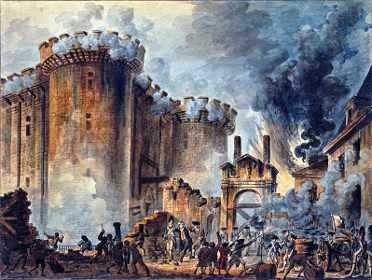Storming of the Bastille

Role of the Fall of the Bastille in the French Revolution
The storming of the Bastille was one of the main events of the French Revolution which resulted in the downfall of the Ancien Regime in France. The fall of the Bastille to the Parisian crowd on July 14, 1789 is viewed as the beginning of the French Revolution because it helped save the newly formed National Constituent Assembly and initiated a process that led to the collapse of the French Monarchy. However, it also gave the revolution a more violent form that reached its height during the so-called Reign of Terror from 1793 to 1794 which was characterized by mass executions of “the enemies of the revolution“.
History of Bastille
The Bastille was a medieval fortress with eight towers dominating the eastern Paris. It was converted into a state prison in the 17th century, while the secret imprisonments without trials gave rise to the horror stories. Although the Bastille was primarily used for influential opponents of the regime who were treated quite well, the medieval fortress became hated as a symbol of absolutism and royal tyranny. But the Parisian crowd stormed the Bastille in 1789 with an aim to get their hands on arms and ammunition that was stored in the fortress rather than to free its prisoners.
Events that Led to the Storming of the Bastille
The social and political unrest in France was nearing the boiling point in summer of 1789. The Third Estate was demanding radical political reforms, while the food scarcity accompanied with the rumors ranging from the aristocracy intentionally starving the people to bands burning the crops provoked a panic among the peasants and hundreds of small riots in the city of Paris. Louis XVI (1774-1793) who feared that the dangerous situation may develop into something more serious tried to prevent it from escalating out of control by concentrating troops around Paris. This move, along with the dismissal of the popular finance minister Jacques Necker on July 11 created an impression that he was preparing for a violent suppression of any opposition.
Fall of the Bastille
Louis’ move had the opposite effect from that intended. The Parisians did not yield to pressure but started to search for weapons around the city.In the morning of July 14, they ransacked the Hotel des Invalides seizing thousands of rifles without any resistance and then moved to the Bastille that was defended by 85 Invalides and 30 Swiss Guards commanded by Bernard-Rene de Launay. Unlike the troops at Hotel des Invalides, de Launay’s garrison resisted for four hours when the commander offered to surrender in return for his life. The Bastille fell and seven prisoners (none of them a political prisoner) were released. De Launay and some of his guards were executed anyway, while the infamous Bastille was demolished by the end of 1789.
Louis’ Reaction to the Storming of the Bastille
After the storming of the Bastille, the Parisians expected a royal counterattack but Louis yielded and withdrew the royal troops stationed at Paris. He also recalled Necker and accepted the tricolor cockade, however, he was unable to reverse the revolutionary movement that later cost him not only his throne but also his head. Louis XVI was executed by guillotine for high treason on January 21, 1793.




